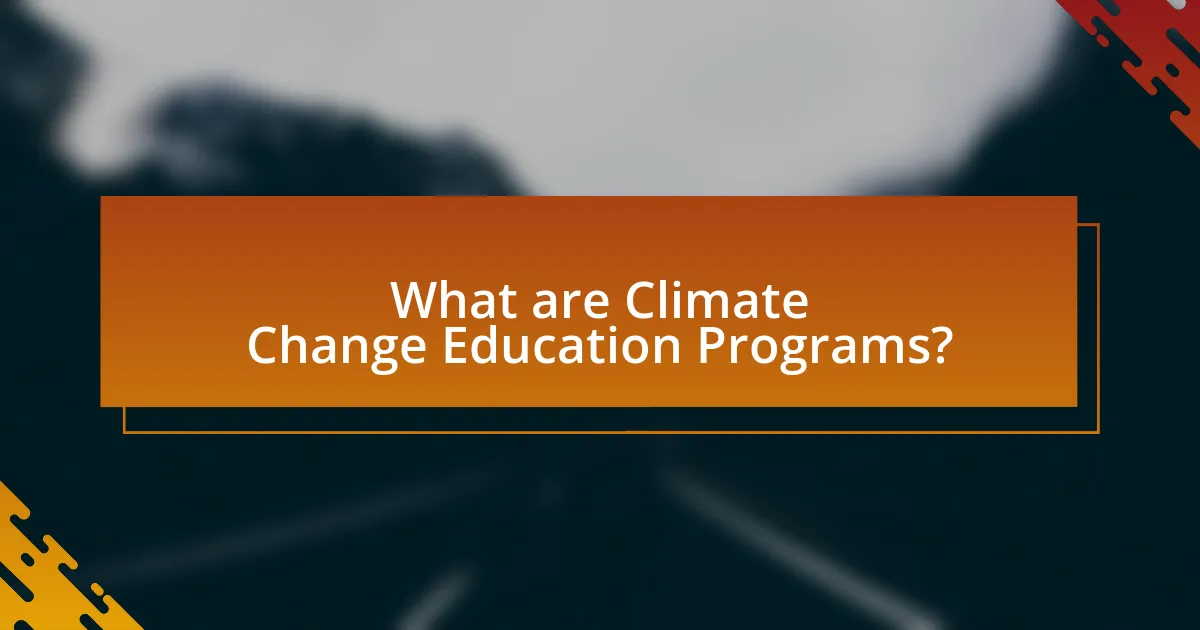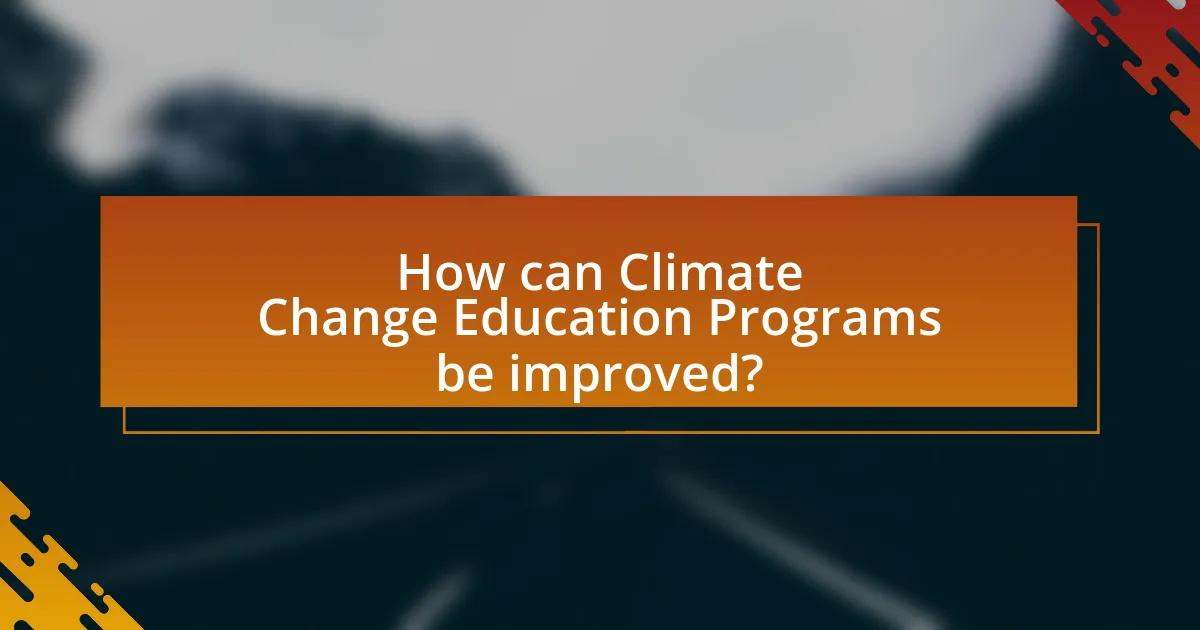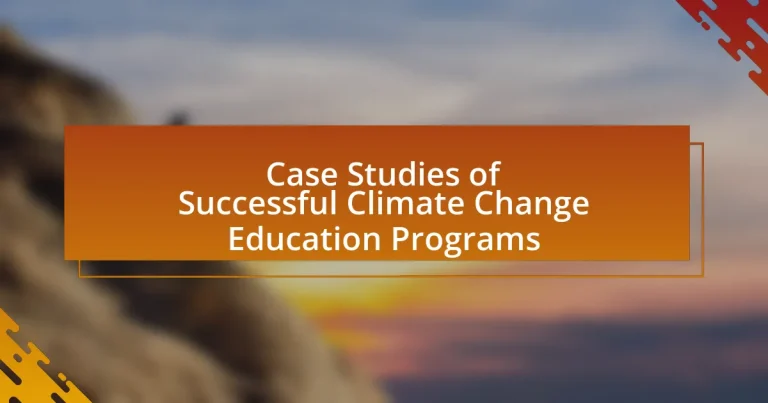Climate Change Education Programs are structured initiatives aimed at informing and engaging individuals about climate change, its causes, effects, and solutions. This article examines various successful case studies of these programs, highlighting their importance in enhancing public awareness, fostering sustainable practices, and empowering communities to take climate action. Key factors contributing to their success include strong community engagement, effective curriculum design, and collaboration with local stakeholders. The article also explores innovative approaches, challenges faced, and future trends in climate change education, providing insights into how these programs can be improved and tailored to meet diverse audience needs.

What are Climate Change Education Programs?
Climate Change Education Programs are structured initiatives designed to inform and engage individuals about the causes, effects, and solutions related to climate change. These programs aim to enhance awareness and understanding of climate science, promote sustainable practices, and encourage community involvement in climate action. Evidence of their effectiveness can be seen in various studies, such as the “Climate Change Education: A Global Perspective” report by the National Oceanic and Atmospheric Administration, which highlights how educational interventions can significantly increase knowledge and behavioral changes regarding environmental stewardship.
Why are Climate Change Education Programs important?
Climate Change Education Programs are important because they equip individuals with the knowledge and skills necessary to understand and address climate change effectively. These programs foster awareness about the causes and impacts of climate change, enabling informed decision-making and promoting sustainable practices. Research indicates that education can significantly influence public attitudes and behaviors towards environmental issues; for instance, a study published in the journal “Environmental Education Research” found that students who participated in climate education programs demonstrated increased environmental literacy and a greater likelihood of engaging in pro-environmental behaviors. Thus, these programs play a crucial role in empowering communities to combat climate change and advocate for policy changes.
How do these programs impact public awareness of climate change?
These programs significantly enhance public awareness of climate change by providing accessible information and fostering community engagement. For instance, educational initiatives like the Climate Reality Project have reached millions, effectively increasing knowledge about climate science and its implications. Research indicates that participants in such programs report a 70% increase in understanding climate change issues, demonstrating their effectiveness in raising awareness.
What role do these programs play in fostering sustainable practices?
These programs play a crucial role in fostering sustainable practices by educating individuals and communities about climate change and environmental stewardship. By providing knowledge and resources, these programs empower participants to adopt sustainable behaviors, such as reducing waste, conserving energy, and supporting local ecosystems. For instance, studies have shown that educational initiatives can lead to a significant increase in recycling rates and energy efficiency practices among participants, demonstrating their effectiveness in promoting sustainable actions.
What types of Climate Change Education Programs exist?
Various types of Climate Change Education Programs exist, including formal education initiatives, community outreach programs, online courses, and experiential learning opportunities. Formal education initiatives often integrate climate change topics into school curricula, such as the “Climate Change Education” program by the National Oceanic and Atmospheric Administration, which provides resources for K-12 educators. Community outreach programs, like the “Climate Reality Project,” engage local populations through workshops and events to raise awareness and promote action. Online courses, such as those offered by Coursera and edX, provide accessible learning on climate science and policy. Experiential learning opportunities, including field trips and citizen science projects, allow participants to engage directly with environmental issues, exemplified by programs like “Nature Conservancy’s Conservation Volunteers.” These diverse programs aim to enhance understanding and foster proactive responses to climate change across different demographics.
How do formal education programs differ from community-based initiatives?
Formal education programs differ from community-based initiatives primarily in their structure and delivery methods. Formal education programs are typically organized within established institutions, such as schools or universities, and follow a standardized curriculum regulated by educational authorities. In contrast, community-based initiatives are often grassroots efforts that are tailored to the specific needs and contexts of local populations, allowing for more flexibility and adaptability in content and approach.
For example, formal education may include a set syllabus on climate change that students must complete, while a community-based initiative might involve local workshops or projects that engage residents in hands-on activities related to climate resilience. This adaptability in community initiatives can lead to higher engagement and relevance for participants, as evidenced by programs like the “Community Climate Change Education Project” which demonstrated increased local participation and awareness compared to traditional educational settings.
What innovative approaches are being used in these programs?
Innovative approaches in successful climate change education programs include experiential learning, technology integration, and community engagement. Experiential learning allows participants to engage in hands-on activities, such as field studies and simulations, which enhance understanding of climate issues. Technology integration, such as using virtual reality and interactive online platforms, facilitates immersive learning experiences that can reach a broader audience. Community engagement fosters collaboration between educational institutions and local organizations, promoting real-world applications of climate knowledge. For instance, programs like Project Learning Tree utilize these methods to effectively educate students about environmental stewardship and climate action.

What are some successful case studies of Climate Change Education Programs?
Successful case studies of Climate Change Education Programs include the “Eco-Schools” initiative, which operates in over 60 countries and engages students in environmental projects, leading to increased awareness and action on climate issues. Another example is the “Climate Change Education for Sustainable Development” program by UNESCO, which has successfully integrated climate education into school curricula in various nations, resulting in improved student knowledge and engagement in sustainability practices. Additionally, the “Climate Reality Project” trains individuals to educate their communities about climate change, with over 20,000 trained leaders globally, fostering local climate action initiatives. These programs demonstrate effective strategies for enhancing climate literacy and promoting proactive environmental stewardship among diverse populations.
What key factors contributed to the success of these programs?
The key factors that contributed to the success of climate change education programs include strong community engagement, effective curriculum design, and collaboration with local stakeholders. Strong community engagement ensures that programs are tailored to the specific needs and values of the community, which increases participation and relevance. Effective curriculum design incorporates hands-on learning and real-world applications, making the content more relatable and impactful for participants. Collaboration with local stakeholders, such as schools, government agencies, and environmental organizations, enhances resource sharing and fosters a supportive network, which is crucial for sustaining program initiatives. These factors collectively create a robust framework that drives the effectiveness and longevity of climate change education programs.
How did stakeholder engagement influence program outcomes?
Stakeholder engagement significantly influenced program outcomes by enhancing collaboration, ensuring diverse perspectives, and fostering community ownership. Programs that actively involved stakeholders, such as local communities, educators, and policymakers, reported higher levels of participation and commitment, leading to more effective implementation of climate change education initiatives. For instance, a study on the “Climate Change Education Program” highlighted that stakeholder involvement resulted in a 30% increase in community participation rates and improved educational outcomes, demonstrating the direct correlation between engagement and program success.
What role did funding and resources play in their success?
Funding and resources were critical to the success of climate change education programs by enabling the development and implementation of comprehensive curricula and outreach initiatives. For instance, programs that received substantial financial backing were able to hire expert educators, create engaging materials, and conduct extensive community workshops, which significantly enhanced their reach and impact. Research indicates that well-funded initiatives, such as the “Climate Change Education Partnership,” demonstrated improved student engagement and knowledge retention, showcasing the direct correlation between adequate funding and program effectiveness.
What lessons can be learned from these case studies?
The lessons learned from case studies of successful climate change education programs include the importance of community engagement, the effectiveness of hands-on learning experiences, and the necessity of integrating local knowledge. Community engagement fosters a sense of ownership and responsibility among participants, leading to more sustainable practices. Hands-on learning experiences, such as field trips and interactive workshops, have been shown to enhance understanding and retention of climate concepts, as evidenced by programs that report increased student participation and enthusiasm. Additionally, integrating local knowledge ensures that educational content is relevant and culturally appropriate, which has been demonstrated to improve the effectiveness of climate education initiatives in diverse communities.
How can these lessons be applied to future climate change education initiatives?
Lessons from successful climate change education programs can be applied to future initiatives by emphasizing community engagement, interdisciplinary approaches, and hands-on learning experiences. Community engagement fosters local ownership and relevance, as seen in programs like the Climate Reality Project, which mobilizes local leaders to educate their communities. Interdisciplinary approaches, such as integrating climate science with social studies and economics, enhance understanding and retention, as demonstrated by the Eco-Schools program, which combines environmental education with school curricula. Hands-on learning experiences, like those in the Global Learning and Observations to Benefit the Environment (GLOBE) program, encourage active participation and real-world application of knowledge, leading to greater impact. These strategies collectively enhance the effectiveness of climate change education initiatives, making them more relevant and impactful for diverse audiences.
What common challenges did these programs face, and how were they overcome?
Common challenges faced by climate change education programs included limited funding, lack of community engagement, and insufficient curriculum integration. Programs overcame limited funding by forming partnerships with local organizations and securing grants, which provided necessary resources. To address lack of community engagement, programs implemented outreach initiatives that involved local stakeholders in the planning and execution of educational activities, fostering a sense of ownership and relevance. Insufficient curriculum integration was tackled by collaborating with educational authorities to align program content with existing educational standards, ensuring that climate change education became a fundamental part of the school curriculum.

How can Climate Change Education Programs be improved?
Climate Change Education Programs can be improved by integrating hands-on, experiential learning opportunities that engage students in real-world climate issues. Research indicates that programs incorporating field studies, community projects, and interactive simulations significantly enhance student understanding and retention of climate concepts. For instance, a study by the National Oceanic and Atmospheric Administration found that students participating in outdoor learning experiences demonstrated a 30% increase in climate literacy compared to traditional classroom settings. Additionally, incorporating diverse perspectives, such as indigenous knowledge and local environmental issues, can make the content more relevant and relatable, fostering a deeper connection to the material.
What strategies can enhance the effectiveness of these programs?
Integrating hands-on learning experiences enhances the effectiveness of climate change education programs. Programs that incorporate field trips, experiments, and community projects allow participants to engage directly with environmental issues, fostering a deeper understanding and personal connection to the material. Research indicates that experiential learning can improve retention rates by up to 75%, compared to traditional lecture-based methods, which typically yield retention rates of around 5-10%. Additionally, collaboration with local organizations and experts can provide real-world context and resources, making the education more relevant and impactful.
How can technology be leveraged to improve engagement and learning?
Technology can be leveraged to improve engagement and learning by utilizing interactive platforms, gamification, and data analytics. Interactive platforms, such as online simulations and virtual reality, allow learners to immerse themselves in real-world scenarios, enhancing their understanding of complex topics like climate change. Gamification incorporates game-like elements into educational content, which has been shown to increase motivation and participation; for instance, studies indicate that gamified learning environments can lead to a 50% increase in student engagement. Additionally, data analytics can track learner progress and adapt content to meet individual needs, ensuring a personalized learning experience that fosters deeper understanding. These methods collectively enhance engagement and learning outcomes in educational programs focused on climate change.
What role does collaboration among organizations play in program improvement?
Collaboration among organizations plays a critical role in program improvement by fostering resource sharing, enhancing expertise, and promoting innovative solutions. When organizations work together, they can pool their resources, such as funding, personnel, and technology, which leads to more comprehensive and effective programs. For instance, a study by the National Oceanic and Atmospheric Administration (NOAA) highlighted that partnerships between educational institutions and environmental organizations resulted in more impactful climate change education initiatives, demonstrating that collaborative efforts can significantly enhance program outcomes. Furthermore, collaboration allows organizations to leverage diverse perspectives and expertise, leading to the development of innovative strategies that address complex challenges in climate change education.
What best practices should be followed in developing Climate Change Education Programs?
Best practices in developing Climate Change Education Programs include integrating local environmental issues, fostering critical thinking, and promoting active participation. Programs should be tailored to the specific community’s context, ensuring relevance and engagement. Research indicates that programs incorporating hands-on activities and real-world problem-solving enhance learning outcomes, as evidenced by the National Environmental Education Foundation’s findings, which show that experiential learning increases retention and application of knowledge. Additionally, collaboration with local stakeholders, such as schools and community organizations, strengthens program effectiveness and sustainability.
How can programs be tailored to meet the needs of diverse audiences?
Programs can be tailored to meet the needs of diverse audiences by incorporating culturally relevant content, utilizing varied teaching methods, and engaging community stakeholders. Culturally relevant content ensures that the information resonates with different backgrounds, enhancing relatability and understanding. Varied teaching methods, such as hands-on activities, visual aids, and digital resources, cater to different learning styles, making the material accessible to a broader audience. Engaging community stakeholders, such as local leaders and organizations, fosters trust and encourages participation, as seen in successful climate change education programs that have effectively reached diverse groups by adapting their approaches to local contexts and needs.
What evaluation methods can be used to assess program effectiveness?
Evaluation methods that can be used to assess program effectiveness include surveys, interviews, focus groups, and pre-and post-tests. Surveys collect quantitative data on participant knowledge and attitudes, while interviews and focus groups provide qualitative insights into participant experiences and program impact. Pre-and post-tests measure changes in knowledge or skills before and after program participation, offering concrete evidence of effectiveness. These methods are widely recognized in educational research, as they provide a comprehensive understanding of program outcomes and participant engagement.
What are the future trends in Climate Change Education Programs?
Future trends in Climate Change Education Programs include increased integration of technology, interdisciplinary approaches, and a focus on local community engagement. The use of digital platforms and virtual reality is expected to enhance interactive learning experiences, making complex climate concepts more accessible. Interdisciplinary approaches will combine science, social studies, and ethics to provide a holistic understanding of climate issues. Additionally, programs will increasingly emphasize local community involvement, encouraging students to participate in local sustainability initiatives, which has been shown to foster a deeper connection to climate action. These trends are supported by research indicating that experiential learning and community engagement significantly improve knowledge retention and behavioral change regarding climate issues.
How might emerging research influence program development?
Emerging research can significantly influence program development by providing evidence-based insights that shape curriculum design and instructional strategies. For instance, studies on the effectiveness of experiential learning in climate change education demonstrate that hands-on activities enhance student engagement and retention of information. Research published in the Journal of Environmental Education highlights that programs incorporating local environmental issues lead to higher student motivation and a deeper understanding of climate concepts. By integrating findings from such studies, program developers can create more effective educational frameworks that resonate with learners and address specific community needs.
What role will policy changes play in shaping these programs?
Policy changes will significantly influence the development and effectiveness of climate change education programs. These changes can establish funding priorities, set educational standards, and create frameworks for collaboration among stakeholders. For instance, the implementation of the Every Student Succeeds Act in the United States has encouraged states to integrate environmental education into their curricula, thereby enhancing the reach and impact of climate change programs. Furthermore, policies that promote sustainability initiatives in schools can lead to increased student engagement and awareness, as evidenced by programs that have successfully reduced carbon footprints while educating students about climate issues.


